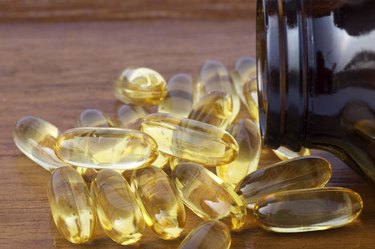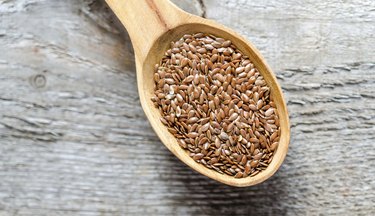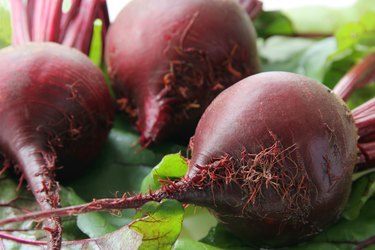
HDL, or high-density lipoproteins, are the "good" cholesterol your body that help to transport excess cholesterol in the blood back to the liver to be broken down. A healthy HDL level in the blood is 60 milligrams per deciliter or higher, with a higher HDL level decreasing risk of heart disease. Consuming certain foods, along with regular exercise, can aid in keeping HDL at a healthy level in the body.
Fish and Fish Oils
Video of the Day

Eating fish several days a week can help to raise HDL cholesterol, according to the University of Massachusetts Medical Center. Especially beneficial are fatty fish, such as salmon, herring and sea bass, which provide good sources of omega-3 fatty acids. Omega-3 fatty acids, according to the British Heart Foundation, help to lower blood triglyceride levels and prevent blood from clotting, which decreases risk of heart disease. Such omega-3 fatty acids have also shown to be effective in fish oil supplement form.
Video of the Day
Nuts, Seeds and Soy

The Harvard School of Public Health recommends at least one source of omega-3 fatty acids a day, which does not necessarily have to be fish. The University of Massachusetts names soy foods, leafy green vegetables, walnuts and flaxseed, as examples of non-fish sources of omega-3 fatty acids.
Purple-Skinned Fruits and Vegetables

Purple-skinned fruits, vegetables and juices have been shown to increase HDL cholesterol levels, according to the University of Massachusetts Medical Center. The Merck Manuals Online Medical Library states that these foods, which include red and purple grapes, red wine and black tea, contain beneficial compounds known as flavonoids that have shown to be protective against heart disease. The antioxidant activity in beets has been shown to decrease triglycerides and total cholesterol, in addition to significantly raising HDL levels.
Complex Carbohydrates

Decreasing refined carbohydrates such as white sugar, white bread and pasta products, as well as sweetened beverages can help to raise HDL cholesterol levels, notes the University of Massachusetts Medical Center. To decrease refined carbohydrates in the diet, focus instead on consuming more fiber-rich, complex carbohydrate sources such as whole grain breads, pastas and cereals. In addition, replace juice and soda with water or unsweetened tea to reduce the refined carbohydrates you consume through beverages.
Related Reading
HDL cholesterol, known as the "good" cholesterol, promotes cardiovascular health by keeping the "bad" cholesterol, known as LDL, at desirable levels. A vegetarian diet can help raise your HDL levels and also keeps your LDL levels down, since animal products are a prime source of LDL cholesterol. Exercise is also vital in raising HDL levels.
Step 1
Choose foods that contain healthy fats. These are the ones that increase HDL cholesterol and lower LDL cholesterol at the same time. Choose polyunsaturated fats, monounsaturated fats and omega-3 fatty acids instead of saturated fats and trans fats. This means eating more fish, olive oil, avocados and nuts and less frozen pizza, cheese and processed snacks.
Step 2
Eat more fiber-filled plant foods. Fiber aids in keeping good cholesterol high and bad cholesterol low. Beans, cruciferous vegetables, apricots and prunes are all good high-fiber choices to incorporate into a vegetarian diet. Berries and kiwi also are high in fiber.
Step 3
Limit alcohol. Cocktails and beer are not restricted on a vegetarian diet, but consuming too much can contribute to unhealthy HDL cholesterol levels. Drinking alcohol in moderation has been shown to increase HDL levels, but you shouldn't drink more than one drink a day if you are female or two a day if you 're male. Too much alcohol contributes to many health problems, including unhealthy cholesterol.
Step 4
Prepare small meals throughout the day instead of two or three large ones. Smaller, more frequent meals are associated with healthy HDL cholesterol levels. Choose foods that have fiber to keep you full until your next meal, and read nutrition labels on any packaged products so you can avoid high amounts of cholesterol.
Step 5
Exercise daily. By eating a vegetarian diet and getting 30 minutes of daily exercise, you can increase your HDL cholesterol levels while also reducing your LDL levels. This combination can also help you lose weight, which increases HDL levels as well.
- Colorado State University: Dietary Fat and Cholesterol
- University of Massachusetts Medical Center: What You Can Do to Raise Your HDL Cholesterol
- British Heart Foundation: What is Cholesterol?
- University of Illinois Extension: Beets
- Merck Manuals Online Medical Library: Atherosclerosis
- American Heart Association: Cooking for Lower Cholesterol
Is this an emergency? If you are experiencing serious medical symptoms, please see the National Library of Medicine’s list of signs you need emergency medical attention or call 911.